A Study of the Impact of Capital Structure on Financial Performance
VerifiedAdded on 2020/02/03
|43
|11221
|324
Report
AI Summary
This report investigates the impact of capital structure on the financial performance of public listed financial institutions, specifically focusing on Jordanian firms. The study utilizes secondary data from sources like annual reports and the Jordan Stock Exchange website, incorporating a comprehensive literature review. Employing regression and descriptive analysis, the research examines the relationship between capital structure and various financial metrics, including operating profit, net profit, return on equity, return on assets, and return on capital employed. The findings reveal a significant impact of capital structure on operating and net profit, while the relationship with other return metrics appears less pronounced. The report delves into the determinants of capital structure, research methodology, data analysis, and concludes with recommendations. The research aims to identify the impact of capital structure on financial performance, exploring determinants, and assessing the relationship between capital structure and key financial indicators. The report also addresses research questions concerning capital structure determinants and its influence on profitability margins and return ratios. The study's significance lies in its potential to aid corporations in optimizing their capital structures, mitigating financial risks, and improving overall financial performance.
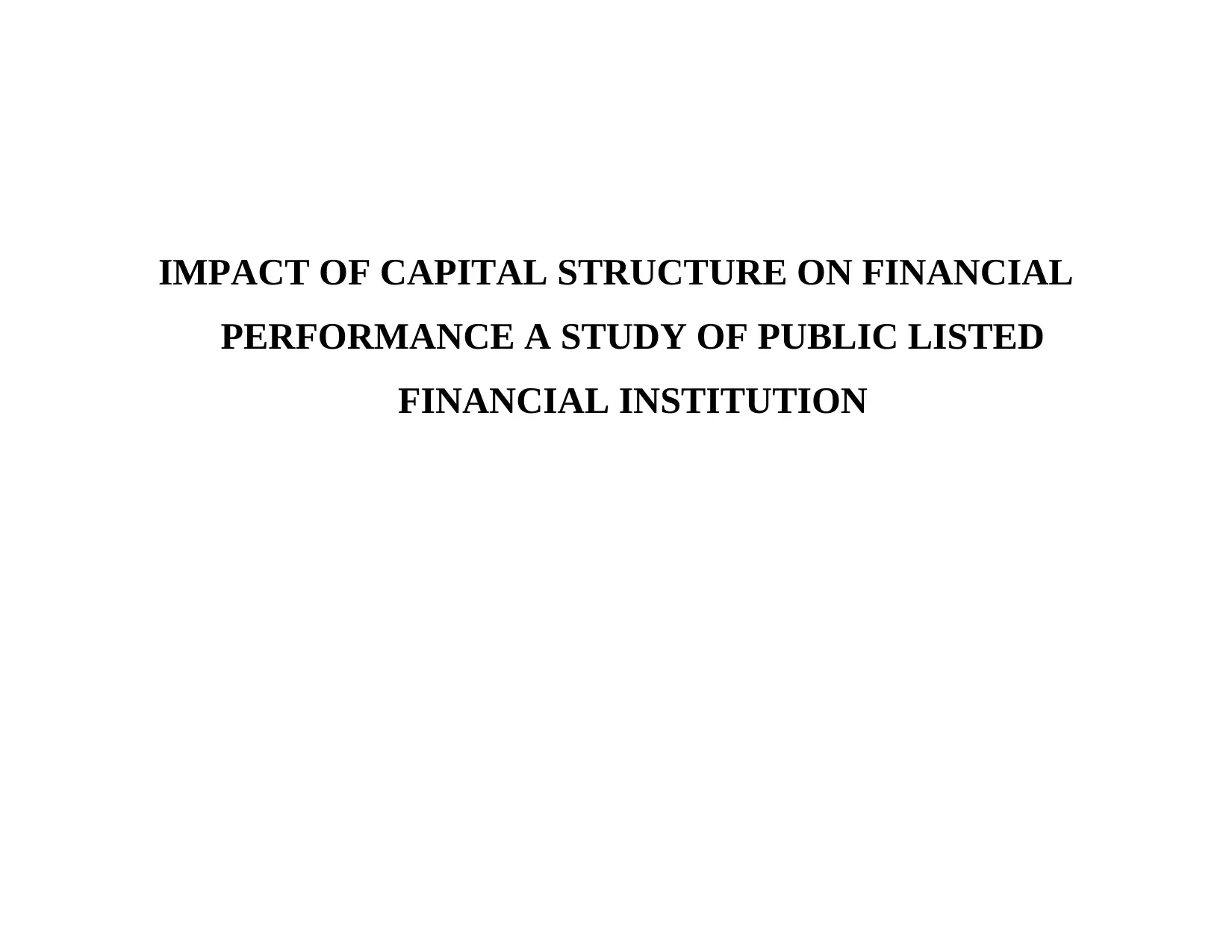
IMPACT OF CAPITAL STRUCTURE ON FINANCIAL
PERFORMANCE A STUDY OF PUBLIC LISTED
FINANCIAL INSTITUTION
PERFORMANCE A STUDY OF PUBLIC LISTED
FINANCIAL INSTITUTION
Paraphrase This Document
Need a fresh take? Get an instant paraphrase of this document with our AI Paraphraser
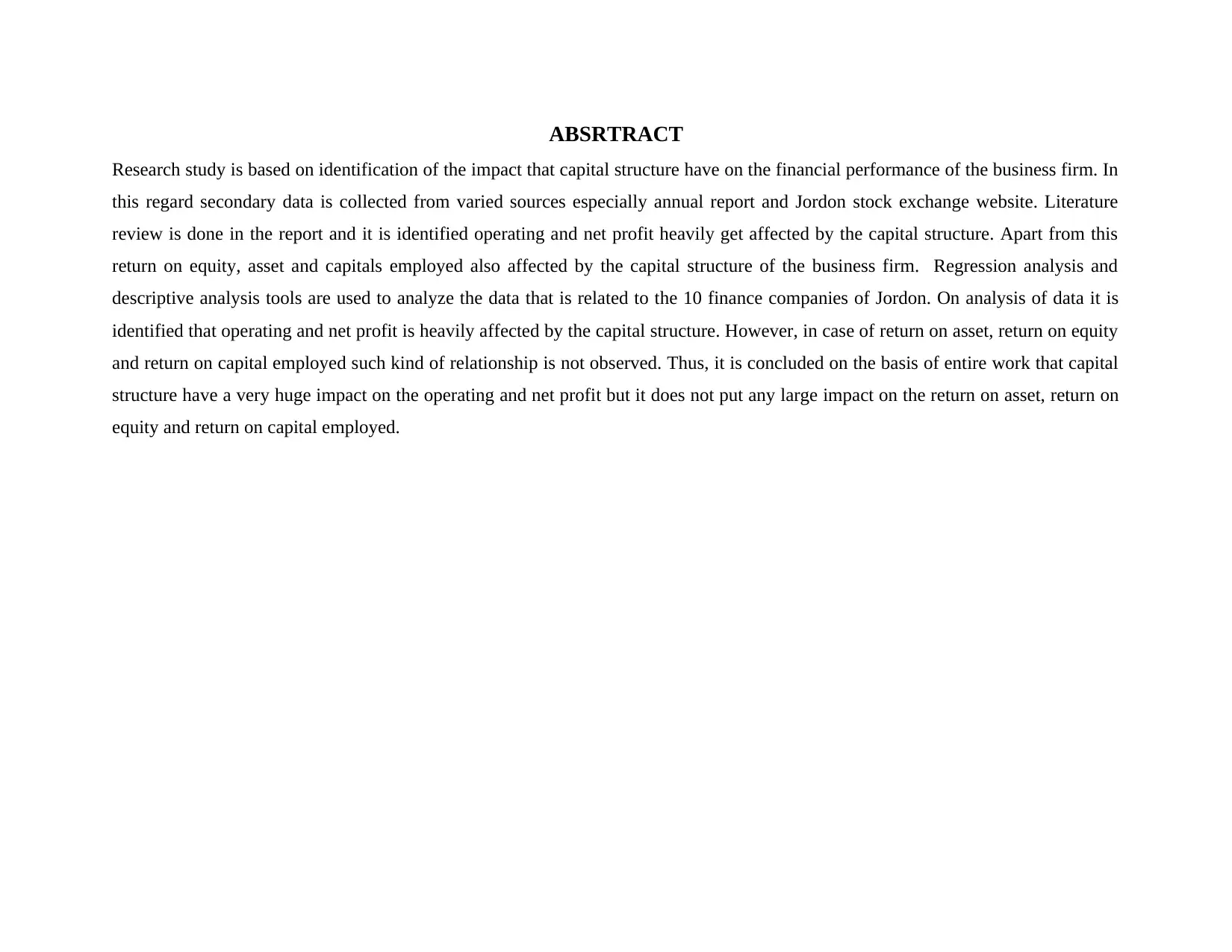
ABSRTRACT
Research study is based on identification of the impact that capital structure have on the financial performance of the business firm. In
this regard secondary data is collected from varied sources especially annual report and Jordon stock exchange website. Literature
review is done in the report and it is identified operating and net profit heavily get affected by the capital structure. Apart from this
return on equity, asset and capitals employed also affected by the capital structure of the business firm. Regression analysis and
descriptive analysis tools are used to analyze the data that is related to the 10 finance companies of Jordon. On analysis of data it is
identified that operating and net profit is heavily affected by the capital structure. However, in case of return on asset, return on equity
and return on capital employed such kind of relationship is not observed. Thus, it is concluded on the basis of entire work that capital
structure have a very huge impact on the operating and net profit but it does not put any large impact on the return on asset, return on
equity and return on capital employed.
Research study is based on identification of the impact that capital structure have on the financial performance of the business firm. In
this regard secondary data is collected from varied sources especially annual report and Jordon stock exchange website. Literature
review is done in the report and it is identified operating and net profit heavily get affected by the capital structure. Apart from this
return on equity, asset and capitals employed also affected by the capital structure of the business firm. Regression analysis and
descriptive analysis tools are used to analyze the data that is related to the 10 finance companies of Jordon. On analysis of data it is
identified that operating and net profit is heavily affected by the capital structure. However, in case of return on asset, return on equity
and return on capital employed such kind of relationship is not observed. Thus, it is concluded on the basis of entire work that capital
structure have a very huge impact on the operating and net profit but it does not put any large impact on the return on asset, return on
equity and return on capital employed.
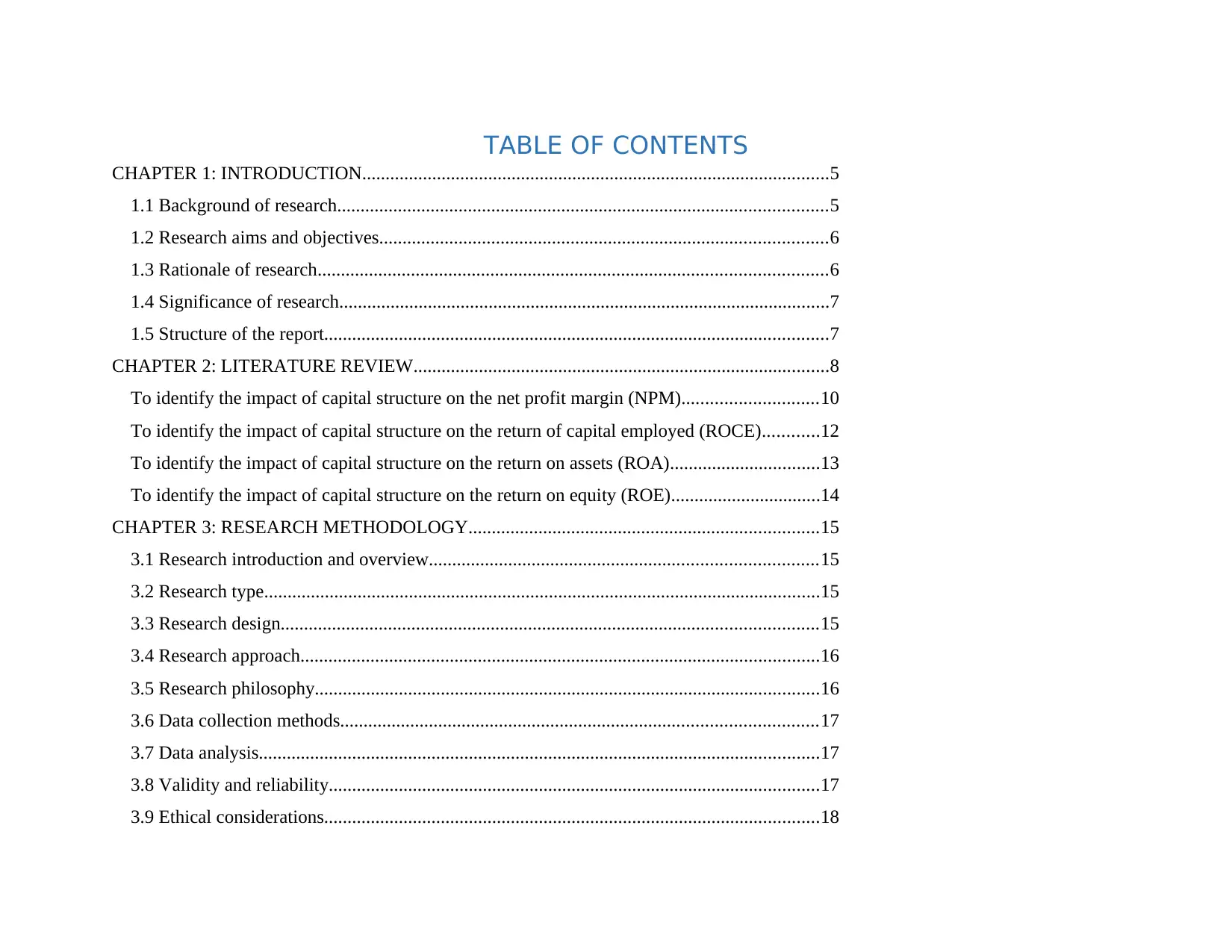
TABLE OF CONTENTS
CHAPTER 1: INTRODUCTION....................................................................................................5
1.1 Background of research.........................................................................................................5
1.2 Research aims and objectives................................................................................................6
1.3 Rationale of research.............................................................................................................6
1.4 Significance of research.........................................................................................................7
1.5 Structure of the report............................................................................................................7
CHAPTER 2: LITERATURE REVIEW.........................................................................................8
To identify the impact of capital structure on the net profit margin (NPM).............................10
To identify the impact of capital structure on the return of capital employed (ROCE)............12
To identify the impact of capital structure on the return on assets (ROA)................................13
To identify the impact of capital structure on the return on equity (ROE)................................14
CHAPTER 3: RESEARCH METHODOLOGY...........................................................................15
3.1 Research introduction and overview...................................................................................15
3.2 Research type.......................................................................................................................15
3.3 Research design...................................................................................................................15
3.4 Research approach...............................................................................................................16
3.5 Research philosophy............................................................................................................16
3.6 Data collection methods......................................................................................................17
3.7 Data analysis........................................................................................................................17
3.8 Validity and reliability.........................................................................................................17
3.9 Ethical considerations..........................................................................................................18
CHAPTER 1: INTRODUCTION....................................................................................................5
1.1 Background of research.........................................................................................................5
1.2 Research aims and objectives................................................................................................6
1.3 Rationale of research.............................................................................................................6
1.4 Significance of research.........................................................................................................7
1.5 Structure of the report............................................................................................................7
CHAPTER 2: LITERATURE REVIEW.........................................................................................8
To identify the impact of capital structure on the net profit margin (NPM).............................10
To identify the impact of capital structure on the return of capital employed (ROCE)............12
To identify the impact of capital structure on the return on assets (ROA)................................13
To identify the impact of capital structure on the return on equity (ROE)................................14
CHAPTER 3: RESEARCH METHODOLOGY...........................................................................15
3.1 Research introduction and overview...................................................................................15
3.2 Research type.......................................................................................................................15
3.3 Research design...................................................................................................................15
3.4 Research approach...............................................................................................................16
3.5 Research philosophy............................................................................................................16
3.6 Data collection methods......................................................................................................17
3.7 Data analysis........................................................................................................................17
3.8 Validity and reliability.........................................................................................................17
3.9 Ethical considerations..........................................................................................................18
⊘ This is a preview!⊘
Do you want full access?
Subscribe today to unlock all pages.

Trusted by 1+ million students worldwide
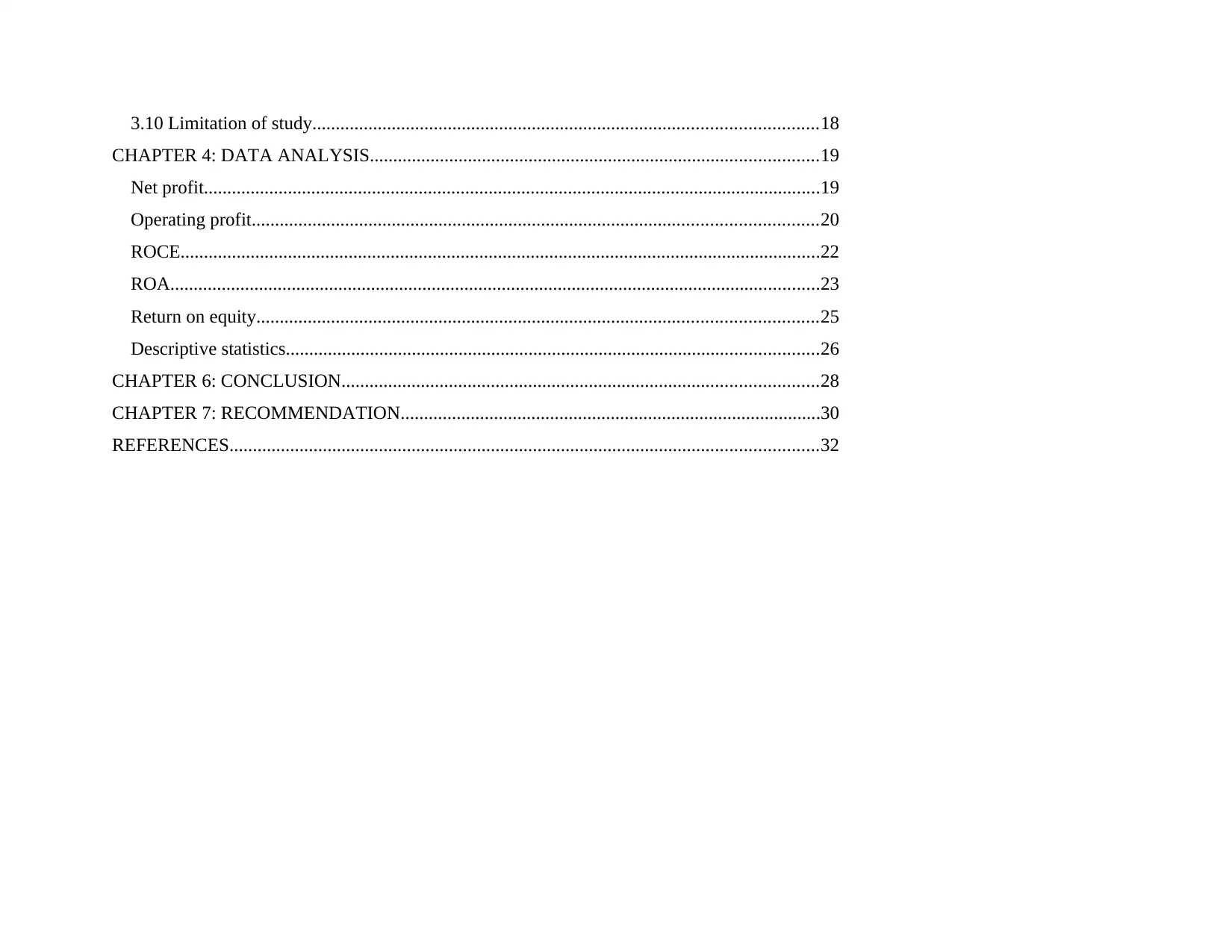
3.10 Limitation of study............................................................................................................18
CHAPTER 4: DATA ANALYSIS................................................................................................19
Net profit....................................................................................................................................19
Operating profit.........................................................................................................................20
ROCE.........................................................................................................................................22
ROA...........................................................................................................................................23
Return on equity........................................................................................................................25
Descriptive statistics..................................................................................................................26
CHAPTER 6: CONCLUSION......................................................................................................28
CHAPTER 7: RECOMMENDATION..........................................................................................30
REFERENCES..............................................................................................................................32
CHAPTER 4: DATA ANALYSIS................................................................................................19
Net profit....................................................................................................................................19
Operating profit.........................................................................................................................20
ROCE.........................................................................................................................................22
ROA...........................................................................................................................................23
Return on equity........................................................................................................................25
Descriptive statistics..................................................................................................................26
CHAPTER 6: CONCLUSION......................................................................................................28
CHAPTER 7: RECOMMENDATION..........................................................................................30
REFERENCES..............................................................................................................................32
Paraphrase This Document
Need a fresh take? Get an instant paraphrase of this document with our AI Paraphraser
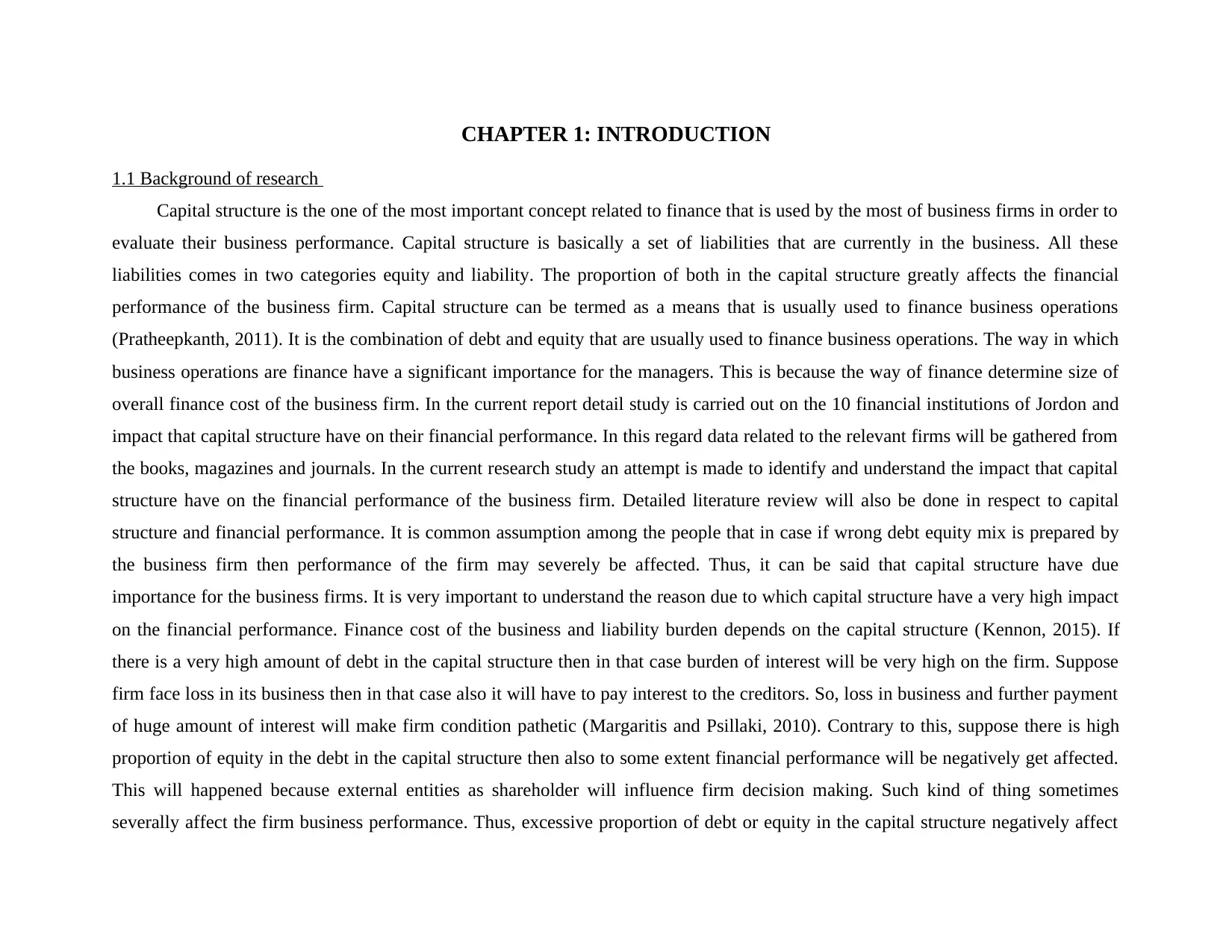
CHAPTER 1: INTRODUCTION
1.1 Background of research
Capital structure is the one of the most important concept related to finance that is used by the most of business firms in order to
evaluate their business performance. Capital structure is basically a set of liabilities that are currently in the business. All these
liabilities comes in two categories equity and liability. The proportion of both in the capital structure greatly affects the financial
performance of the business firm. Capital structure can be termed as a means that is usually used to finance business operations
(Pratheepkanth, 2011). It is the combination of debt and equity that are usually used to finance business operations. The way in which
business operations are finance have a significant importance for the managers. This is because the way of finance determine size of
overall finance cost of the business firm. In the current report detail study is carried out on the 10 financial institutions of Jordon and
impact that capital structure have on their financial performance. In this regard data related to the relevant firms will be gathered from
the books, magazines and journals. In the current research study an attempt is made to identify and understand the impact that capital
structure have on the financial performance of the business firm. Detailed literature review will also be done in respect to capital
structure and financial performance. It is common assumption among the people that in case if wrong debt equity mix is prepared by
the business firm then performance of the firm may severely be affected. Thus, it can be said that capital structure have due
importance for the business firms. It is very important to understand the reason due to which capital structure have a very high impact
on the financial performance. Finance cost of the business and liability burden depends on the capital structure (Kennon, 2015). If
there is a very high amount of debt in the capital structure then in that case burden of interest will be very high on the firm. Suppose
firm face loss in its business then in that case also it will have to pay interest to the creditors. So, loss in business and further payment
of huge amount of interest will make firm condition pathetic (Margaritis and Psillaki, 2010). Contrary to this, suppose there is high
proportion of equity in the debt in the capital structure then also to some extent financial performance will be negatively get affected.
This will happened because external entities as shareholder will influence firm decision making. Such kind of thing sometimes
severally affect the firm business performance. Thus, excessive proportion of debt or equity in the capital structure negatively affect
1.1 Background of research
Capital structure is the one of the most important concept related to finance that is used by the most of business firms in order to
evaluate their business performance. Capital structure is basically a set of liabilities that are currently in the business. All these
liabilities comes in two categories equity and liability. The proportion of both in the capital structure greatly affects the financial
performance of the business firm. Capital structure can be termed as a means that is usually used to finance business operations
(Pratheepkanth, 2011). It is the combination of debt and equity that are usually used to finance business operations. The way in which
business operations are finance have a significant importance for the managers. This is because the way of finance determine size of
overall finance cost of the business firm. In the current report detail study is carried out on the 10 financial institutions of Jordon and
impact that capital structure have on their financial performance. In this regard data related to the relevant firms will be gathered from
the books, magazines and journals. In the current research study an attempt is made to identify and understand the impact that capital
structure have on the financial performance of the business firm. Detailed literature review will also be done in respect to capital
structure and financial performance. It is common assumption among the people that in case if wrong debt equity mix is prepared by
the business firm then performance of the firm may severely be affected. Thus, it can be said that capital structure have due
importance for the business firms. It is very important to understand the reason due to which capital structure have a very high impact
on the financial performance. Finance cost of the business and liability burden depends on the capital structure (Kennon, 2015). If
there is a very high amount of debt in the capital structure then in that case burden of interest will be very high on the firm. Suppose
firm face loss in its business then in that case also it will have to pay interest to the creditors. So, loss in business and further payment
of huge amount of interest will make firm condition pathetic (Margaritis and Psillaki, 2010). Contrary to this, suppose there is high
proportion of equity in the debt in the capital structure then also to some extent financial performance will be negatively get affected.
This will happened because external entities as shareholder will influence firm decision making. Such kind of thing sometimes
severally affect the firm business performance. Thus, excessive proportion of debt or equity in the capital structure negatively affect
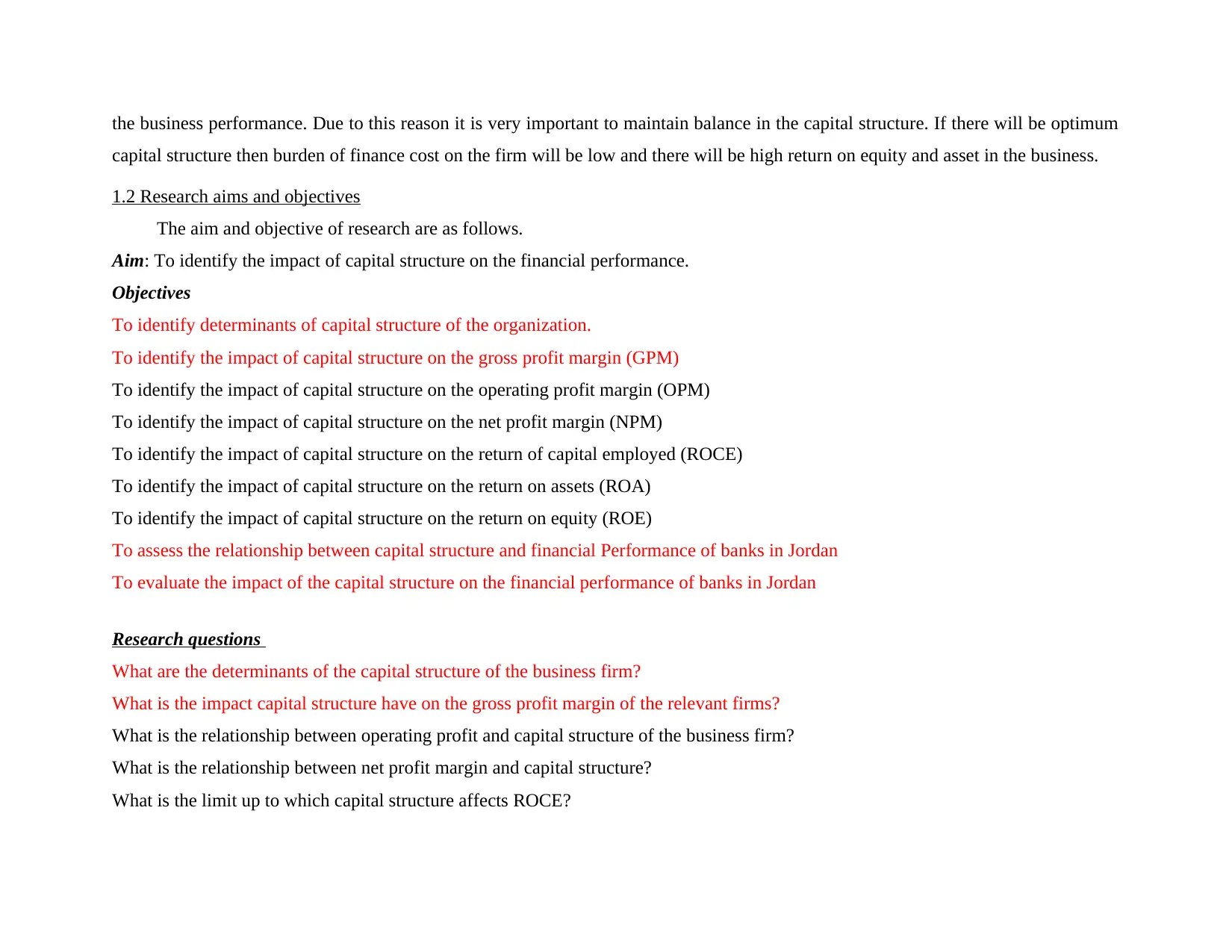
the business performance. Due to this reason it is very important to maintain balance in the capital structure. If there will be optimum
capital structure then burden of finance cost on the firm will be low and there will be high return on equity and asset in the business.
1.2 Research aims and objectives
The aim and objective of research are as follows.
Aim: To identify the impact of capital structure on the financial performance.
Objectives
To identify determinants of capital structure of the organization.
To identify the impact of capital structure on the gross profit margin (GPM)
To identify the impact of capital structure on the operating profit margin (OPM)
To identify the impact of capital structure on the net profit margin (NPM)
To identify the impact of capital structure on the return of capital employed (ROCE)
To identify the impact of capital structure on the return on assets (ROA)
To identify the impact of capital structure on the return on equity (ROE)
To assess the relationship between capital structure and financial Performance of banks in Jordan
To evaluate the impact of the capital structure on the financial performance of banks in Jordan
Research questions
What are the determinants of the capital structure of the business firm?
What is the impact capital structure have on the gross profit margin of the relevant firms?
What is the relationship between operating profit and capital structure of the business firm?
What is the relationship between net profit margin and capital structure?
What is the limit up to which capital structure affects ROCE?
capital structure then burden of finance cost on the firm will be low and there will be high return on equity and asset in the business.
1.2 Research aims and objectives
The aim and objective of research are as follows.
Aim: To identify the impact of capital structure on the financial performance.
Objectives
To identify determinants of capital structure of the organization.
To identify the impact of capital structure on the gross profit margin (GPM)
To identify the impact of capital structure on the operating profit margin (OPM)
To identify the impact of capital structure on the net profit margin (NPM)
To identify the impact of capital structure on the return of capital employed (ROCE)
To identify the impact of capital structure on the return on assets (ROA)
To identify the impact of capital structure on the return on equity (ROE)
To assess the relationship between capital structure and financial Performance of banks in Jordan
To evaluate the impact of the capital structure on the financial performance of banks in Jordan
Research questions
What are the determinants of the capital structure of the business firm?
What is the impact capital structure have on the gross profit margin of the relevant firms?
What is the relationship between operating profit and capital structure of the business firm?
What is the relationship between net profit margin and capital structure?
What is the limit up to which capital structure affects ROCE?
⊘ This is a preview!⊘
Do you want full access?
Subscribe today to unlock all pages.

Trusted by 1+ million students worldwide
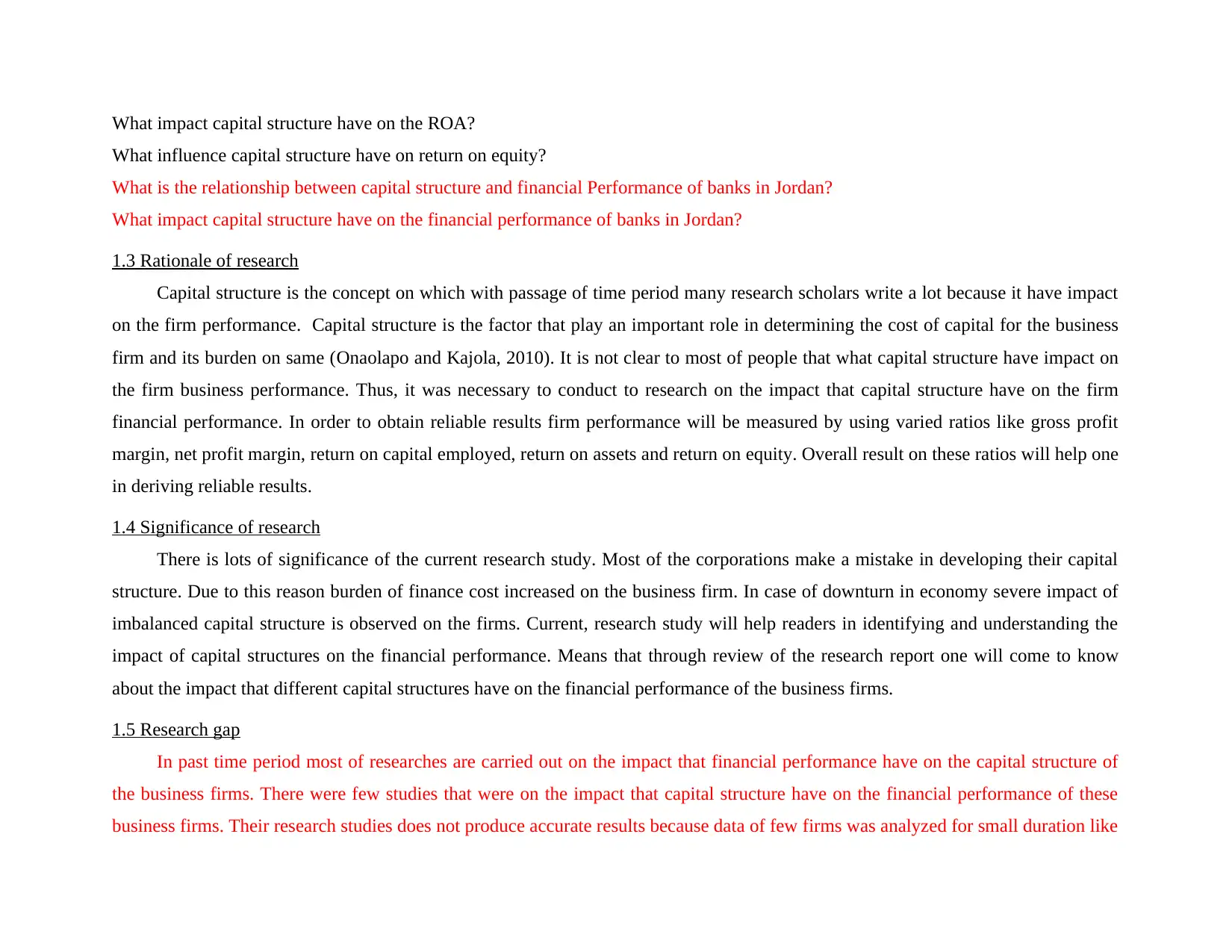
What impact capital structure have on the ROA?
What influence capital structure have on return on equity?
What is the relationship between capital structure and financial Performance of banks in Jordan?
What impact capital structure have on the financial performance of banks in Jordan?
1.3 Rationale of research
Capital structure is the concept on which with passage of time period many research scholars write a lot because it have impact
on the firm performance. Capital structure is the factor that play an important role in determining the cost of capital for the business
firm and its burden on same (Onaolapo and Kajola, 2010). It is not clear to most of people that what capital structure have impact on
the firm business performance. Thus, it was necessary to conduct to research on the impact that capital structure have on the firm
financial performance. In order to obtain reliable results firm performance will be measured by using varied ratios like gross profit
margin, net profit margin, return on capital employed, return on assets and return on equity. Overall result on these ratios will help one
in deriving reliable results.
1.4 Significance of research
There is lots of significance of the current research study. Most of the corporations make a mistake in developing their capital
structure. Due to this reason burden of finance cost increased on the business firm. In case of downturn in economy severe impact of
imbalanced capital structure is observed on the firms. Current, research study will help readers in identifying and understanding the
impact of capital structures on the financial performance. Means that through review of the research report one will come to know
about the impact that different capital structures have on the financial performance of the business firms.
1.5 Research gap
In past time period most of researches are carried out on the impact that financial performance have on the capital structure of
the business firms. There were few studies that were on the impact that capital structure have on the financial performance of these
business firms. Their research studies does not produce accurate results because data of few firms was analyzed for small duration like
What influence capital structure have on return on equity?
What is the relationship between capital structure and financial Performance of banks in Jordan?
What impact capital structure have on the financial performance of banks in Jordan?
1.3 Rationale of research
Capital structure is the concept on which with passage of time period many research scholars write a lot because it have impact
on the firm performance. Capital structure is the factor that play an important role in determining the cost of capital for the business
firm and its burden on same (Onaolapo and Kajola, 2010). It is not clear to most of people that what capital structure have impact on
the firm business performance. Thus, it was necessary to conduct to research on the impact that capital structure have on the firm
financial performance. In order to obtain reliable results firm performance will be measured by using varied ratios like gross profit
margin, net profit margin, return on capital employed, return on assets and return on equity. Overall result on these ratios will help one
in deriving reliable results.
1.4 Significance of research
There is lots of significance of the current research study. Most of the corporations make a mistake in developing their capital
structure. Due to this reason burden of finance cost increased on the business firm. In case of downturn in economy severe impact of
imbalanced capital structure is observed on the firms. Current, research study will help readers in identifying and understanding the
impact of capital structures on the financial performance. Means that through review of the research report one will come to know
about the impact that different capital structures have on the financial performance of the business firms.
1.5 Research gap
In past time period most of researches are carried out on the impact that financial performance have on the capital structure of
the business firms. There were few studies that were on the impact that capital structure have on the financial performance of these
business firms. Their research studies does not produce accurate results because data of few firms was analyzed for small duration like
Paraphrase This Document
Need a fresh take? Get an instant paraphrase of this document with our AI Paraphraser
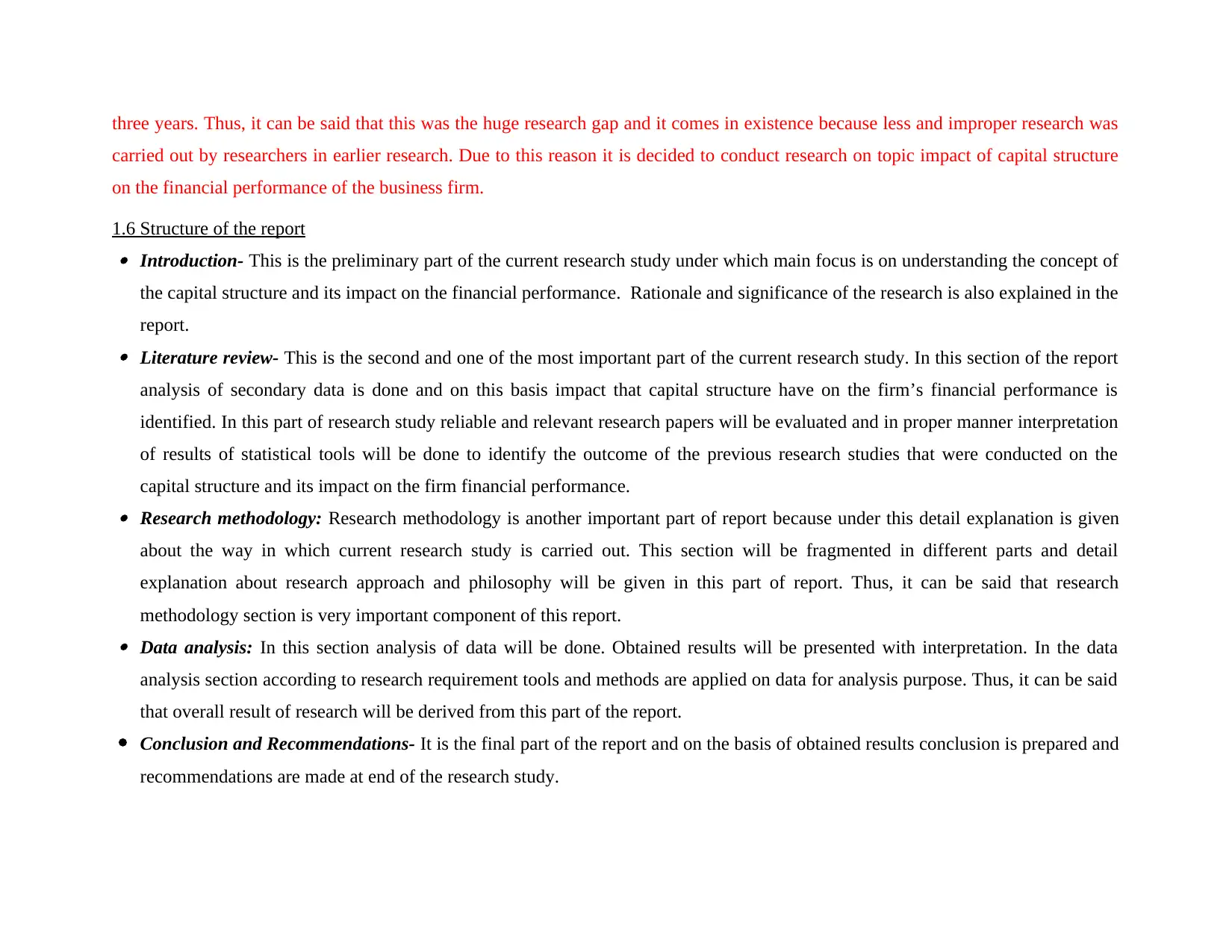
three years. Thus, it can be said that this was the huge research gap and it comes in existence because less and improper research was
carried out by researchers in earlier research. Due to this reason it is decided to conduct research on topic impact of capital structure
on the financial performance of the business firm.
1.6 Structure of the report Introduction- This is the preliminary part of the current research study under which main focus is on understanding the concept of
the capital structure and its impact on the financial performance. Rationale and significance of the research is also explained in the
report. Literature review- This is the second and one of the most important part of the current research study. In this section of the report
analysis of secondary data is done and on this basis impact that capital structure have on the firm’s financial performance is
identified. In this part of research study reliable and relevant research papers will be evaluated and in proper manner interpretation
of results of statistical tools will be done to identify the outcome of the previous research studies that were conducted on the
capital structure and its impact on the firm financial performance. Research methodology: Research methodology is another important part of report because under this detail explanation is given
about the way in which current research study is carried out. This section will be fragmented in different parts and detail
explanation about research approach and philosophy will be given in this part of report. Thus, it can be said that research
methodology section is very important component of this report. Data analysis: In this section analysis of data will be done. Obtained results will be presented with interpretation. In the data
analysis section according to research requirement tools and methods are applied on data for analysis purpose. Thus, it can be said
that overall result of research will be derived from this part of the report.
Conclusion and Recommendations- It is the final part of the report and on the basis of obtained results conclusion is prepared and
recommendations are made at end of the research study.
carried out by researchers in earlier research. Due to this reason it is decided to conduct research on topic impact of capital structure
on the financial performance of the business firm.
1.6 Structure of the report Introduction- This is the preliminary part of the current research study under which main focus is on understanding the concept of
the capital structure and its impact on the financial performance. Rationale and significance of the research is also explained in the
report. Literature review- This is the second and one of the most important part of the current research study. In this section of the report
analysis of secondary data is done and on this basis impact that capital structure have on the firm’s financial performance is
identified. In this part of research study reliable and relevant research papers will be evaluated and in proper manner interpretation
of results of statistical tools will be done to identify the outcome of the previous research studies that were conducted on the
capital structure and its impact on the firm financial performance. Research methodology: Research methodology is another important part of report because under this detail explanation is given
about the way in which current research study is carried out. This section will be fragmented in different parts and detail
explanation about research approach and philosophy will be given in this part of report. Thus, it can be said that research
methodology section is very important component of this report. Data analysis: In this section analysis of data will be done. Obtained results will be presented with interpretation. In the data
analysis section according to research requirement tools and methods are applied on data for analysis purpose. Thus, it can be said
that overall result of research will be derived from this part of the report.
Conclusion and Recommendations- It is the final part of the report and on the basis of obtained results conclusion is prepared and
recommendations are made at end of the research study.
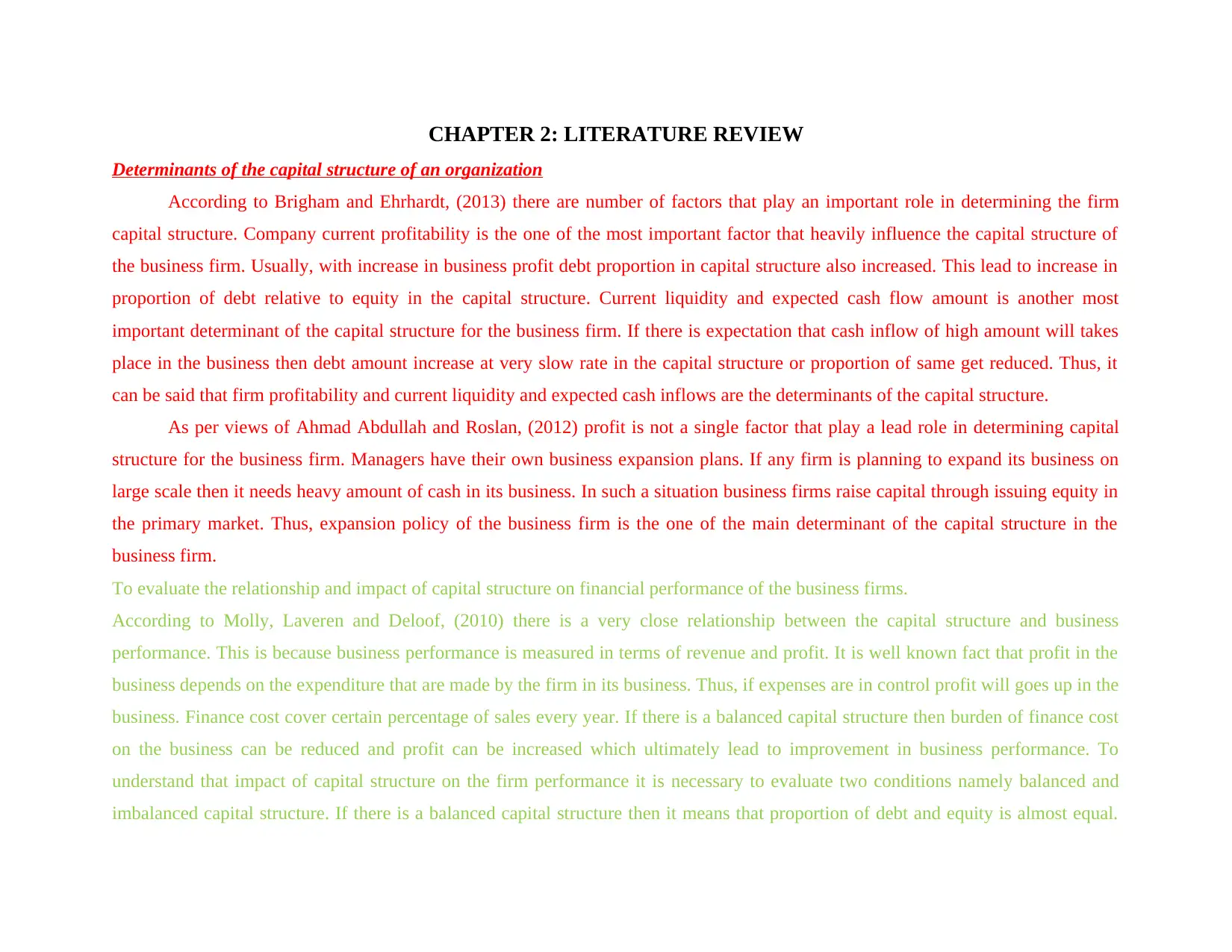
CHAPTER 2: LITERATURE REVIEW
Determinants of the capital structure of an organization
According to Brigham and Ehrhardt, (2013) there are number of factors that play an important role in determining the firm
capital structure. Company current profitability is the one of the most important factor that heavily influence the capital structure of
the business firm. Usually, with increase in business profit debt proportion in capital structure also increased. This lead to increase in
proportion of debt relative to equity in the capital structure. Current liquidity and expected cash flow amount is another most
important determinant of the capital structure for the business firm. If there is expectation that cash inflow of high amount will takes
place in the business then debt amount increase at very slow rate in the capital structure or proportion of same get reduced. Thus, it
can be said that firm profitability and current liquidity and expected cash inflows are the determinants of the capital structure.
As per views of Ahmad Abdullah and Roslan, (2012) profit is not a single factor that play a lead role in determining capital
structure for the business firm. Managers have their own business expansion plans. If any firm is planning to expand its business on
large scale then it needs heavy amount of cash in its business. In such a situation business firms raise capital through issuing equity in
the primary market. Thus, expansion policy of the business firm is the one of the main determinant of the capital structure in the
business firm.
To evaluate the relationship and impact of capital structure on financial performance of the business firms.
According to Molly, Laveren and Deloof, (2010) there is a very close relationship between the capital structure and business
performance. This is because business performance is measured in terms of revenue and profit. It is well known fact that profit in the
business depends on the expenditure that are made by the firm in its business. Thus, if expenses are in control profit will goes up in the
business. Finance cost cover certain percentage of sales every year. If there is a balanced capital structure then burden of finance cost
on the business can be reduced and profit can be increased which ultimately lead to improvement in business performance. To
understand that impact of capital structure on the firm performance it is necessary to evaluate two conditions namely balanced and
imbalanced capital structure. If there is a balanced capital structure then it means that proportion of debt and equity is almost equal.
Determinants of the capital structure of an organization
According to Brigham and Ehrhardt, (2013) there are number of factors that play an important role in determining the firm
capital structure. Company current profitability is the one of the most important factor that heavily influence the capital structure of
the business firm. Usually, with increase in business profit debt proportion in capital structure also increased. This lead to increase in
proportion of debt relative to equity in the capital structure. Current liquidity and expected cash flow amount is another most
important determinant of the capital structure for the business firm. If there is expectation that cash inflow of high amount will takes
place in the business then debt amount increase at very slow rate in the capital structure or proportion of same get reduced. Thus, it
can be said that firm profitability and current liquidity and expected cash inflows are the determinants of the capital structure.
As per views of Ahmad Abdullah and Roslan, (2012) profit is not a single factor that play a lead role in determining capital
structure for the business firm. Managers have their own business expansion plans. If any firm is planning to expand its business on
large scale then it needs heavy amount of cash in its business. In such a situation business firms raise capital through issuing equity in
the primary market. Thus, expansion policy of the business firm is the one of the main determinant of the capital structure in the
business firm.
To evaluate the relationship and impact of capital structure on financial performance of the business firms.
According to Molly, Laveren and Deloof, (2010) there is a very close relationship between the capital structure and business
performance. This is because business performance is measured in terms of revenue and profit. It is well known fact that profit in the
business depends on the expenditure that are made by the firm in its business. Thus, if expenses are in control profit will goes up in the
business. Finance cost cover certain percentage of sales every year. If there is a balanced capital structure then burden of finance cost
on the business can be reduced and profit can be increased which ultimately lead to improvement in business performance. To
understand that impact of capital structure on the firm performance it is necessary to evaluate two conditions namely balanced and
imbalanced capital structure. If there is a balanced capital structure then it means that proportion of debt and equity is almost equal.
⊘ This is a preview!⊘
Do you want full access?
Subscribe today to unlock all pages.

Trusted by 1+ million students worldwide
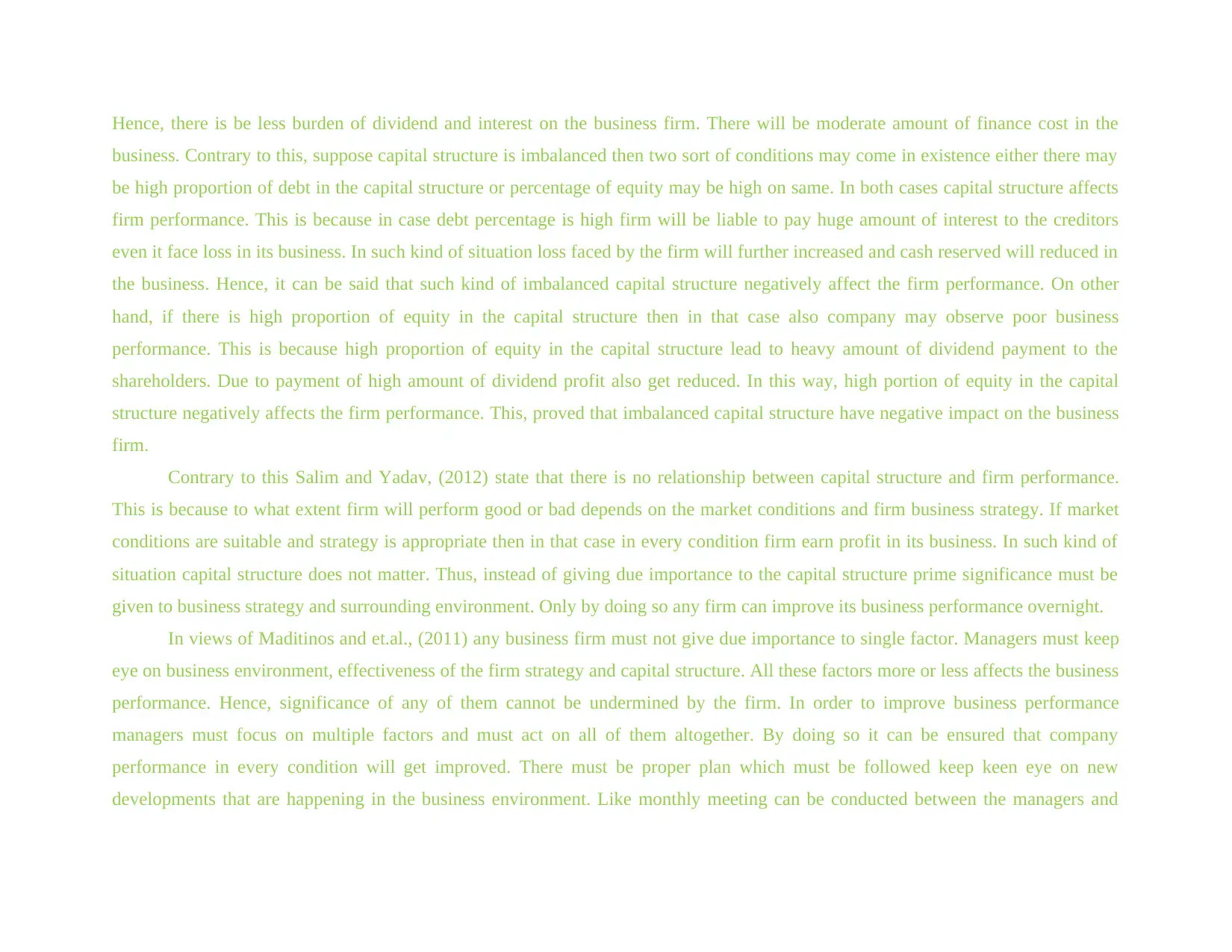
Hence, there is be less burden of dividend and interest on the business firm. There will be moderate amount of finance cost in the
business. Contrary to this, suppose capital structure is imbalanced then two sort of conditions may come in existence either there may
be high proportion of debt in the capital structure or percentage of equity may be high on same. In both cases capital structure affects
firm performance. This is because in case debt percentage is high firm will be liable to pay huge amount of interest to the creditors
even it face loss in its business. In such kind of situation loss faced by the firm will further increased and cash reserved will reduced in
the business. Hence, it can be said that such kind of imbalanced capital structure negatively affect the firm performance. On other
hand, if there is high proportion of equity in the capital structure then in that case also company may observe poor business
performance. This is because high proportion of equity in the capital structure lead to heavy amount of dividend payment to the
shareholders. Due to payment of high amount of dividend profit also get reduced. In this way, high portion of equity in the capital
structure negatively affects the firm performance. This, proved that imbalanced capital structure have negative impact on the business
firm.
Contrary to this Salim and Yadav, (2012) state that there is no relationship between capital structure and firm performance.
This is because to what extent firm will perform good or bad depends on the market conditions and firm business strategy. If market
conditions are suitable and strategy is appropriate then in that case in every condition firm earn profit in its business. In such kind of
situation capital structure does not matter. Thus, instead of giving due importance to the capital structure prime significance must be
given to business strategy and surrounding environment. Only by doing so any firm can improve its business performance overnight.
In views of Maditinos and et.al., (2011) any business firm must not give due importance to single factor. Managers must keep
eye on business environment, effectiveness of the firm strategy and capital structure. All these factors more or less affects the business
performance. Hence, significance of any of them cannot be undermined by the firm. In order to improve business performance
managers must focus on multiple factors and must act on all of them altogether. By doing so it can be ensured that company
performance in every condition will get improved. There must be proper plan which must be followed keep keen eye on new
developments that are happening in the business environment. Like monthly meeting can be conducted between the managers and
business. Contrary to this, suppose capital structure is imbalanced then two sort of conditions may come in existence either there may
be high proportion of debt in the capital structure or percentage of equity may be high on same. In both cases capital structure affects
firm performance. This is because in case debt percentage is high firm will be liable to pay huge amount of interest to the creditors
even it face loss in its business. In such kind of situation loss faced by the firm will further increased and cash reserved will reduced in
the business. Hence, it can be said that such kind of imbalanced capital structure negatively affect the firm performance. On other
hand, if there is high proportion of equity in the capital structure then in that case also company may observe poor business
performance. This is because high proportion of equity in the capital structure lead to heavy amount of dividend payment to the
shareholders. Due to payment of high amount of dividend profit also get reduced. In this way, high portion of equity in the capital
structure negatively affects the firm performance. This, proved that imbalanced capital structure have negative impact on the business
firm.
Contrary to this Salim and Yadav, (2012) state that there is no relationship between capital structure and firm performance.
This is because to what extent firm will perform good or bad depends on the market conditions and firm business strategy. If market
conditions are suitable and strategy is appropriate then in that case in every condition firm earn profit in its business. In such kind of
situation capital structure does not matter. Thus, instead of giving due importance to the capital structure prime significance must be
given to business strategy and surrounding environment. Only by doing so any firm can improve its business performance overnight.
In views of Maditinos and et.al., (2011) any business firm must not give due importance to single factor. Managers must keep
eye on business environment, effectiveness of the firm strategy and capital structure. All these factors more or less affects the business
performance. Hence, significance of any of them cannot be undermined by the firm. In order to improve business performance
managers must focus on multiple factors and must act on all of them altogether. By doing so it can be ensured that company
performance in every condition will get improved. There must be proper plan which must be followed keep keen eye on new
developments that are happening in the business environment. Like monthly meeting can be conducted between the managers and
Paraphrase This Document
Need a fresh take? Get an instant paraphrase of this document with our AI Paraphraser
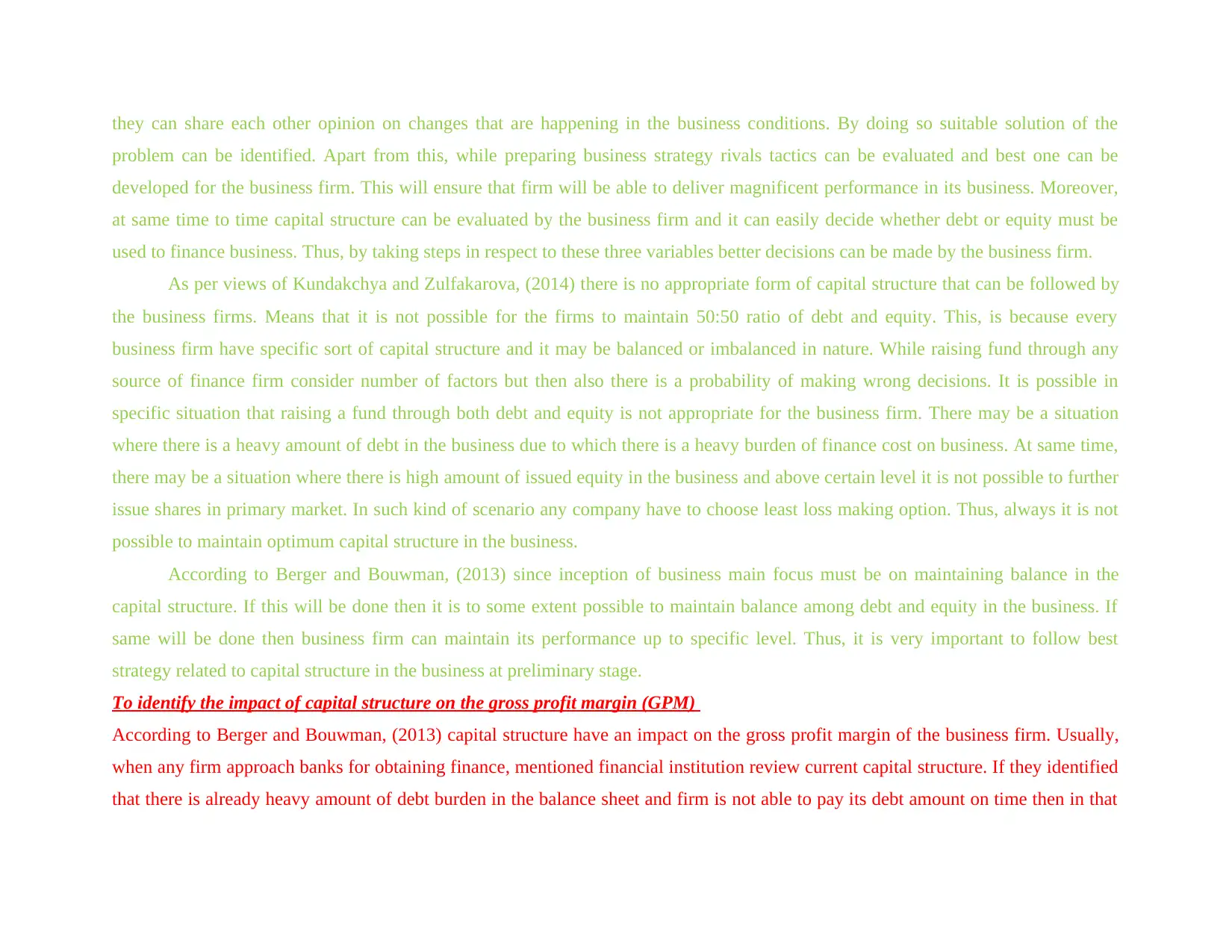
they can share each other opinion on changes that are happening in the business conditions. By doing so suitable solution of the
problem can be identified. Apart from this, while preparing business strategy rivals tactics can be evaluated and best one can be
developed for the business firm. This will ensure that firm will be able to deliver magnificent performance in its business. Moreover,
at same time to time capital structure can be evaluated by the business firm and it can easily decide whether debt or equity must be
used to finance business. Thus, by taking steps in respect to these three variables better decisions can be made by the business firm.
As per views of Kundakchya and Zulfakarova, (2014) there is no appropriate form of capital structure that can be followed by
the business firms. Means that it is not possible for the firms to maintain 50:50 ratio of debt and equity. This, is because every
business firm have specific sort of capital structure and it may be balanced or imbalanced in nature. While raising fund through any
source of finance firm consider number of factors but then also there is a probability of making wrong decisions. It is possible in
specific situation that raising a fund through both debt and equity is not appropriate for the business firm. There may be a situation
where there is a heavy amount of debt in the business due to which there is a heavy burden of finance cost on business. At same time,
there may be a situation where there is high amount of issued equity in the business and above certain level it is not possible to further
issue shares in primary market. In such kind of scenario any company have to choose least loss making option. Thus, always it is not
possible to maintain optimum capital structure in the business.
According to Berger and Bouwman, (2013) since inception of business main focus must be on maintaining balance in the
capital structure. If this will be done then it is to some extent possible to maintain balance among debt and equity in the business. If
same will be done then business firm can maintain its performance up to specific level. Thus, it is very important to follow best
strategy related to capital structure in the business at preliminary stage.
To identify the impact of capital structure on the gross profit margin (GPM)
According to Berger and Bouwman, (2013) capital structure have an impact on the gross profit margin of the business firm. Usually,
when any firm approach banks for obtaining finance, mentioned financial institution review current capital structure. If they identified
that there is already heavy amount of debt burden in the balance sheet and firm is not able to pay its debt amount on time then in that
problem can be identified. Apart from this, while preparing business strategy rivals tactics can be evaluated and best one can be
developed for the business firm. This will ensure that firm will be able to deliver magnificent performance in its business. Moreover,
at same time to time capital structure can be evaluated by the business firm and it can easily decide whether debt or equity must be
used to finance business. Thus, by taking steps in respect to these three variables better decisions can be made by the business firm.
As per views of Kundakchya and Zulfakarova, (2014) there is no appropriate form of capital structure that can be followed by
the business firms. Means that it is not possible for the firms to maintain 50:50 ratio of debt and equity. This, is because every
business firm have specific sort of capital structure and it may be balanced or imbalanced in nature. While raising fund through any
source of finance firm consider number of factors but then also there is a probability of making wrong decisions. It is possible in
specific situation that raising a fund through both debt and equity is not appropriate for the business firm. There may be a situation
where there is a heavy amount of debt in the business due to which there is a heavy burden of finance cost on business. At same time,
there may be a situation where there is high amount of issued equity in the business and above certain level it is not possible to further
issue shares in primary market. In such kind of scenario any company have to choose least loss making option. Thus, always it is not
possible to maintain optimum capital structure in the business.
According to Berger and Bouwman, (2013) since inception of business main focus must be on maintaining balance in the
capital structure. If this will be done then it is to some extent possible to maintain balance among debt and equity in the business. If
same will be done then business firm can maintain its performance up to specific level. Thus, it is very important to follow best
strategy related to capital structure in the business at preliminary stage.
To identify the impact of capital structure on the gross profit margin (GPM)
According to Berger and Bouwman, (2013) capital structure have an impact on the gross profit margin of the business firm. Usually,
when any firm approach banks for obtaining finance, mentioned financial institution review current capital structure. If they identified
that there is already heavy amount of debt burden in the balance sheet and firm is not able to pay its debt amount on time then in that
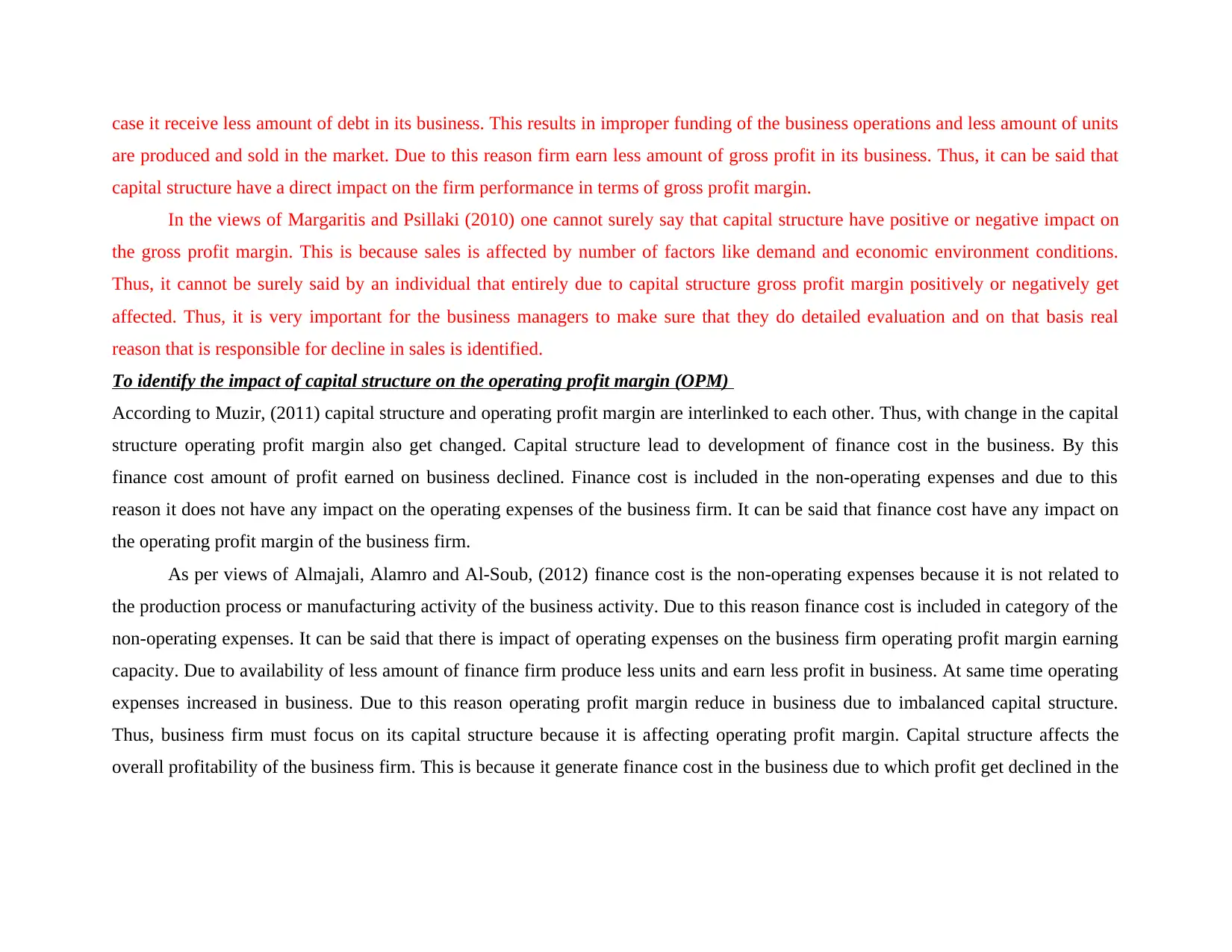
case it receive less amount of debt in its business. This results in improper funding of the business operations and less amount of units
are produced and sold in the market. Due to this reason firm earn less amount of gross profit in its business. Thus, it can be said that
capital structure have a direct impact on the firm performance in terms of gross profit margin.
In the views of Margaritis and Psillaki (2010) one cannot surely say that capital structure have positive or negative impact on
the gross profit margin. This is because sales is affected by number of factors like demand and economic environment conditions.
Thus, it cannot be surely said by an individual that entirely due to capital structure gross profit margin positively or negatively get
affected. Thus, it is very important for the business managers to make sure that they do detailed evaluation and on that basis real
reason that is responsible for decline in sales is identified.
To identify the impact of capital structure on the operating profit margin (OPM)
According to Muzir, (2011) capital structure and operating profit margin are interlinked to each other. Thus, with change in the capital
structure operating profit margin also get changed. Capital structure lead to development of finance cost in the business. By this
finance cost amount of profit earned on business declined. Finance cost is included in the non-operating expenses and due to this
reason it does not have any impact on the operating expenses of the business firm. It can be said that finance cost have any impact on
the operating profit margin of the business firm.
As per views of Almajali, Alamro and Al-Soub, (2012) finance cost is the non-operating expenses because it is not related to
the production process or manufacturing activity of the business activity. Due to this reason finance cost is included in category of the
non-operating expenses. It can be said that there is impact of operating expenses on the business firm operating profit margin earning
capacity. Due to availability of less amount of finance firm produce less units and earn less profit in business. At same time operating
expenses increased in business. Due to this reason operating profit margin reduce in business due to imbalanced capital structure.
Thus, business firm must focus on its capital structure because it is affecting operating profit margin. Capital structure affects the
overall profitability of the business firm. This is because it generate finance cost in the business due to which profit get declined in the
are produced and sold in the market. Due to this reason firm earn less amount of gross profit in its business. Thus, it can be said that
capital structure have a direct impact on the firm performance in terms of gross profit margin.
In the views of Margaritis and Psillaki (2010) one cannot surely say that capital structure have positive or negative impact on
the gross profit margin. This is because sales is affected by number of factors like demand and economic environment conditions.
Thus, it cannot be surely said by an individual that entirely due to capital structure gross profit margin positively or negatively get
affected. Thus, it is very important for the business managers to make sure that they do detailed evaluation and on that basis real
reason that is responsible for decline in sales is identified.
To identify the impact of capital structure on the operating profit margin (OPM)
According to Muzir, (2011) capital structure and operating profit margin are interlinked to each other. Thus, with change in the capital
structure operating profit margin also get changed. Capital structure lead to development of finance cost in the business. By this
finance cost amount of profit earned on business declined. Finance cost is included in the non-operating expenses and due to this
reason it does not have any impact on the operating expenses of the business firm. It can be said that finance cost have any impact on
the operating profit margin of the business firm.
As per views of Almajali, Alamro and Al-Soub, (2012) finance cost is the non-operating expenses because it is not related to
the production process or manufacturing activity of the business activity. Due to this reason finance cost is included in category of the
non-operating expenses. It can be said that there is impact of operating expenses on the business firm operating profit margin earning
capacity. Due to availability of less amount of finance firm produce less units and earn less profit in business. At same time operating
expenses increased in business. Due to this reason operating profit margin reduce in business due to imbalanced capital structure.
Thus, business firm must focus on its capital structure because it is affecting operating profit margin. Capital structure affects the
overall profitability of the business firm. This is because it generate finance cost in the business due to which profit get declined in the
⊘ This is a preview!⊘
Do you want full access?
Subscribe today to unlock all pages.

Trusted by 1+ million students worldwide
1 out of 43
Related Documents
Your All-in-One AI-Powered Toolkit for Academic Success.
+13062052269
info@desklib.com
Available 24*7 on WhatsApp / Email
![[object Object]](/_next/static/media/star-bottom.7253800d.svg)
Unlock your academic potential
Copyright © 2020–2025 A2Z Services. All Rights Reserved. Developed and managed by ZUCOL.





